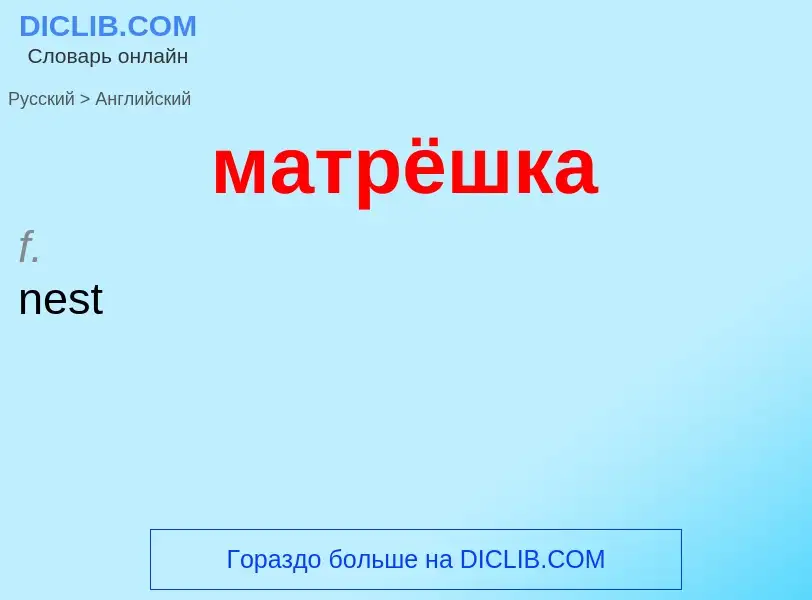Перевод и анализ слов искусственным интеллектом ChatGPT
На этой странице Вы можете получить подробный анализ слова или словосочетания, произведенный с помощью лучшей на сегодняшний день технологии искусственного интеллекта:
- как употребляется слово
- частота употребления
- используется оно чаще в устной или письменной речи
- варианты перевода слова
- примеры употребления (несколько фраз с переводом)
- этимология
матрёшка - перевод на Английский
nest
['nestid'dɔl]
общая лексика
«матрёшка» (кукла)
Определение
1) а) Русская игрушка в виде деревянной расписной куклы, внутри которой находятся такие же куклы меньшего размера.
б) Одна из таких кукол.
2) перен. Полная, румяная, круглолицая девочка, девушка, напоминающая такую куклу.
Википедия

Matryoshka dolls ( MAT-ree-OSH-kə; Russian: матрёшка, IPA: [mɐˈtrʲɵʂkə] (listen)), also known as stacking dolls, nesting dolls, Russian tea dolls, or Russian dolls, are a set of wooden dolls of decreasing size placed one inside another. The name matryoshka, mainly known as "little matron", is a diminutive form of Matryosha (Матрёша), in turn a diminutive of the Russian female first name Matryona (Матрёна).
A set of matryoshkas consists of a wooden figure, which separates at the middle, top from bottom, to reveal a smaller figure of the same sort inside, which has, in turn, another figure inside of it, and so on.
The first Russian nested doll set was made in 1890 by wood turning craftsman and wood carver Vasily Zvyozdochkin from a design by Sergey Malyutin, who was a folk crafts painter at Abramtsevo. Traditionally the outer layer is a woman, dressed in a sarafan, a long and shapeless traditional Russian peasant jumper dress. The figures inside may be of any gender; the smallest, innermost doll is typically a baby turned from a single piece of wood. Much of the artistry is in the painting of each doll, which can be very elaborate. The dolls often follow a theme; the themes may vary, from fairy tale characters to Soviet leaders. In the West, matryoshka dolls are often referred to as babushka dolls, though they are not known by this name in Russian; babushka (бабушка) means "grandmother" or "old woman".


![Matryoshka dolls in [[Tallinn]], [[Estonia]] Matryoshka dolls in [[Tallinn]], [[Estonia]]](https://commons.wikimedia.org/wiki/Special:FilePath/07-06-21-tallinn-by-RalfR-191.jpg?width=200)
![Malyutin]], 1892 Malyutin]], 1892](https://commons.wikimedia.org/wiki/Special:FilePath/First matryoshka museum doll open.jpg?width=200)




